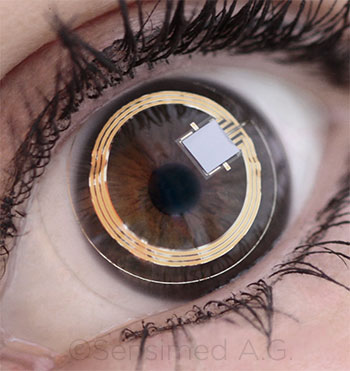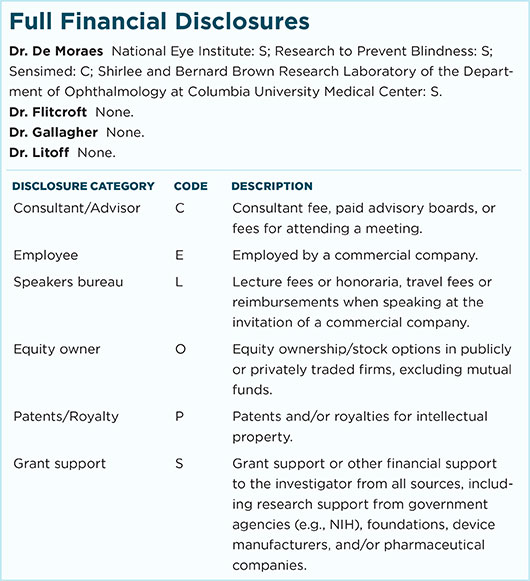Download PDF
Glaucoma specialists have long struggled with a diagnostic challenge: How do you get a true measure of IOP, which varies throughout the day, peaking at night and in the early morning, when patients typically are sleeping? Researchers at Columbia University Medical School reported that they have found an answer with a contact lens that has a built-in sensor (CLS).1 This “smart lens,” the Sensimed Triggerfish, detects a 24-hour IOP pattern, or “signature,” which corresponds to tonometric readings made in a sleep laboratory.
Moreover, they say that IOP monitoring with the CLS—performed while patients carry out their usual routines at home—gives valuable insight into glaucoma progression. “In a single day, using the 24-hour IOP information, we can do a better job in predicting progression than multiple visits over years taking snapshot IOP measures,” said lead author Carlos Gustavo De Moraes, MD, MPH. He is associate professor of ophthalmology at Columbia.
 |
TRACKING CHANGE. The contact lens detects change in corneal shape as a surrogate for IOP change and transmits the data to a wireless recorder.
|
Study details. The prospective cross-sectional study evaluated 40 treated (using an average of 2.6 medications) open-angle glaucoma patients between ages 40 and 89. For at least 2 years before the date of CLS monitoring, subjects underwent 8 or more visual field (VF) tests. On the basis of the VF tests, half of the subjects were classified as slow progressors, and the other half as fast progressors. IOP measurements during the study period were 20 mm Hg or less, averaging 16 mm Hg.
After placing the lens in the participants, the researchers looked at individuals’ IOP patterns over 24 hours. The CLS does not measure IOP directly; rather, it senses changes in the corneal curvature, which are strongly associated with IOP. As eye pressure fluctuates, the curve changes, which generates an electrical signal that is transmitted to a wireless recording device worn by the patient.
Patterns linked with progression. The researchers then assessed the relationship between the 24-hour CLS parameters and the classification of fast or slow progression as measured by VF mean deviation. They found that the parameters significantly associated with faster glaucoma progression included the number of large peaks in pressure, the troughs, the magnitude of a peak, and how quickly it occurred. The best predictors of fast progression were the number of long peaks and the mean peak ratio when patients were awake.
Dr. De Moraes noted that by the time of lens placement, the speed of progression had slowed significantly for many of the fast progressors, probably as a result of their medical therapy. Nevertheless, some patients were still progressing faster than others. For example, patients with steeper spikes recorded overnight and a greater number of peaks in the profile tended to have faster glaucoma progression. “Without information from the contact lens system, those patients would continue to progress at an undesired fast speed in the following years,” he said.
Future developments. A larger study of up to 1,000 patients is now under way to further elucidate the results of this exploratory study. The Triggerfish, already available in Europe, just received FDA approval, and Dr. De Moraes predicted “in the near future, ophthalmologists will monitor IOP in a very different way than they do today.”
In the meantime, he said, the study shows the importance of looking at IOP variation over 24 hours, and not just at single measurements during office hours. “With the information we can obtain through the contact lens system, we can now tailor therapy and prevent progression in high-risk patients.”
—Miriam Karmel
___________________________
1 De Moraes CG et al. Ophthalmology. 2016;123(4):744-753.
___________________________
Relevant financial disclosures: Dr. De Moraes—Sensimed: C.
For full disclosures and disclosure key, see below.

More from this month’s News in Review